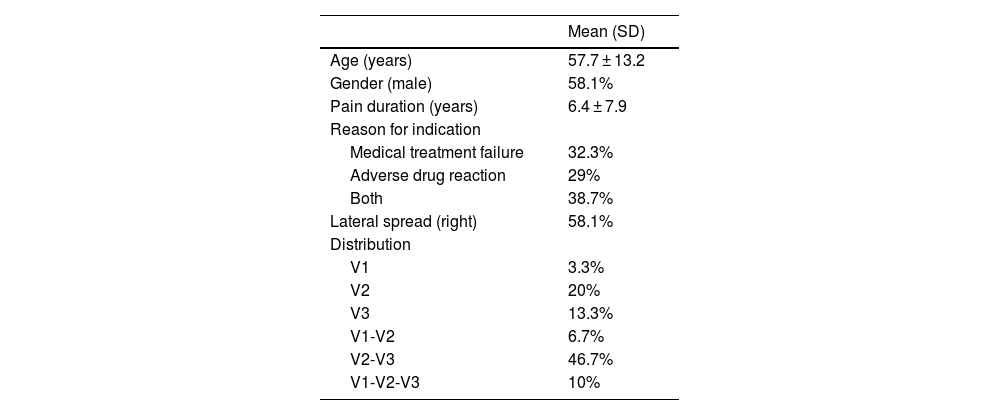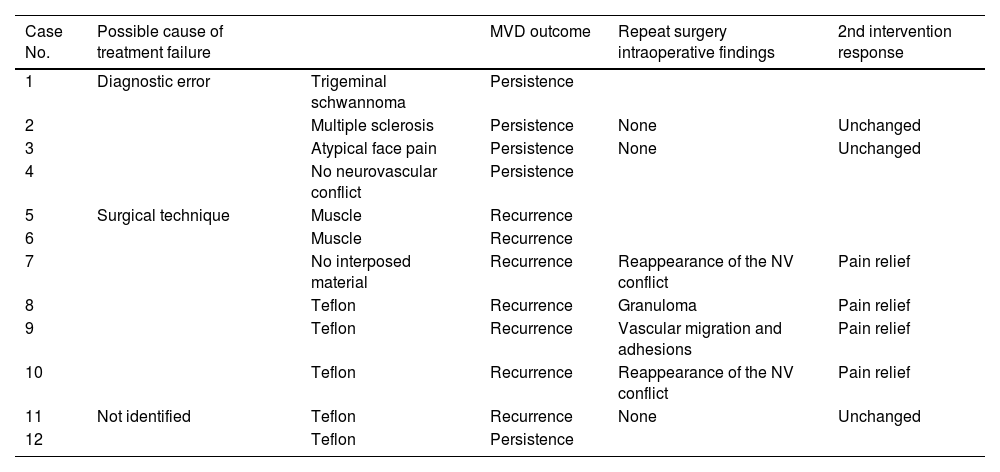Microvascular decompression (MVD) is a non-ablative technique aimed at relieving pain in trigeminal neuralgia (TN) by resolving a neurovascular conflict. Despite reported high success rates, a significant percentage of patients experience therapeutic failure.
MethodsRetrospective observational study of patients with suspected TN undergoing MVD was performed with the goal of identifying factors contributing to the persistence and recurrence of pain.
ResultsIn the present study, 31 patients undergoing 38 MVD procedures for TN were included (7 patients underwent reoperation after the failure of the initial operation). The mean age was 58.5 years with a male predominance (58.1%). The mean duration of pain was 6.4 years, mainly affecting branches V2 and V3 (46.7%). The most frequently described neurovascular conflict was with the superior cerebellar artery (54.8%), predominantly resolved with Teflon (75.9%).
In our case series, MVD achieved pain control in 80.6% of patients at one-year post-intervention and 61.3% at the end of the follow-up period. Twelve patients experienced MVD failure: 5 cases of persistent pain and 7 cases of pain recurrence. A detailed analysis of these failures identified misdiagnosis as the reason of persistent pain in 4 patients, while inadequate surgical technique could be the cause of pain recurrence in 6 patients.
ConclusionIn our study, therapeutic failures could mainly be attributed to two factors: misdiagnosis or the use of inappropriate materials. These factors should be considered when optimizing the management of DMV in patients with NT.
La descompresión microvascular (DMV) es una técnica no ablativa dirigida a aliviar el dolor en la neuralgia del trigémino (NT) mediante la resolución del conflicto neurovascular. A pesar de haberse descrito altas cifras de éxito, un significativo porcentaje de pacientes sufren fracaso terapéutico.
MétodosEstudio observacional retrospectivo de pacientes con sospecha de NT y sometidos a DMV con el objetivo de identificar los factores que determinaron la persistencia y recurrencia del dolor.
ResultadosEn el presente estudio fueron incluidos 31 pacientes sometidos a 38 procedimientos de DMV por NT (7 pacientes fueron reintervenidos tras el fracaso de la primera operación). La edad media fue 58,5 años con predominio del sexo masculino (58,1%). El tiempo medio de evolución del dolor era 6,4 años afectando principalmente ramas V2 y V3 (46.7%). El conflicto neurovascular más frecuentemente descrito fue con la arteria cerebelosa superior (54.8%), y fue resuelto generalmente con teflón (75,9%).
En nuestra serie de casos, la DMV obtuvo control del dolor en el 80.6% al año de la intervención, y el 61,3% al final periodo de seguimiento. Doce pacientes presentaron fracaso de la DMV: 5 casos de dolor persistente, y 7 casos de recurrencia del dolor. Un análisis detallado de estos fracasos determinó un diagnóstico erróneo como causa de dolor persistente en 4 pacientes, mientras que la interposición de materiales inadecuados para la resolución del conflicto neurovascular pudo ser el motivo de la recurrencia del dolor en otros 6 pacientes.
ConclusiónEn nuestro estudio, los fracasos terapéuticos pudieron ser atribuidos a dos factores principalmente: diagnóstico erróneo y la interposición de un material inadecuado. Estos factores deben considerarse en la optimización del manejo de la DMV en paciente con NT.
Article

If it is the first time you have accessed you can obtain your credentials by contacting Elsevier Spain in suscripciones@elsevier.com or by calling our Customer Service at902 88 87 40 if you are calling from Spain or at +34 932 418 800 (from 9 to 18h., GMT + 1) if you are calling outside of Spain.
If you already have your login data, please click here .
If you have forgotten your password you can you can recover it by clicking here and selecting the option ¿I have forgotten my password¿.












